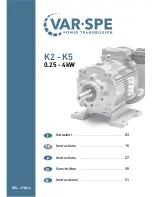
15
SUBSEQUENT READJUSTMENT
Once the engine has been run-in and the controls properly
set up, it should be unnecessary to alter the mixture settings;
except to make minor adjustments to the Needle-Valve
occasionally, to take account of variations in climatic
conditions. The use of a different fuel, however, particularly
one containing more, or less, nitromethane and/or a different
type or proportion of lubricating oil, is likely to call for some
readjustment of the Needle-Valve. Remember that, as a
safety measure, it is advisable to increase the Needle-Valve
opening by an extra half-turn counter-clockwise, prior to
establishing a new setting. The same applies if the silencer
type is changed. A different silencer may alter the exhaust
pressure applied to the fuel feed and call for a revised
Needle-Valve setting. The use of a different glowplug may
also require compensating carburetor readjustments.
CARBURETOR CLEANLINESS
The correct functioning of the carburetor depends on its small
fuel orifices remaining clear. The minute particles of foreign
matter that are present in any fuel, can easily partially obstruct
these orifices and upset mixture strength so that engine per-
formance becomes erratic and unreliable.
O.S.'Super-Filters' ( large and small ) are available, as optional
extras, to deal with this problem. One of these filters, fitted to
the outlet tube inside your refueling container, will prevent the
entry of foreign material into the fuel tank.
It is also recommended that a good in-line filter be installed
between the tank and needle-valve. Do not forget to clean the
filters regularly to remove dirt and lint that accumulate on the
filter screen. Also, clean the carburettor itself occasionally.
ENGINE CARE AND MAINTENANCE
At the end of each operating session, drain out any fuel that
may remain in the fuel tank.
Next, energize the glowplug and try to restart the engine to
burn off any fuel that may remain inside the engine. Repeat
this procedure until the engine fails to fire. Remove the
glowplug and eject any residue by rotating the engine with
an electric starter for 4 to 5 seconds while the engine is still
warm.
Finally, inject some corrosion inhibiting after-run oil into the
engine. Rotate the engine a few times by hand, to make
sure that it is free, and then with an electric starter for 4 to 5
seconds to distribute the oil to all the working parts.
Do not inject corrosion inhibiting after-run oil into the
carburettor as this may cause the O-ring inside the car-
burettor to deteriorate.
These procedures will reduce the risk of starting difficulties
and of internal corrosion after a period of storage.
Note:
1.
2.
3.
14





























